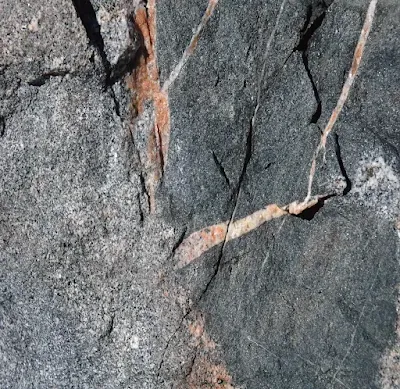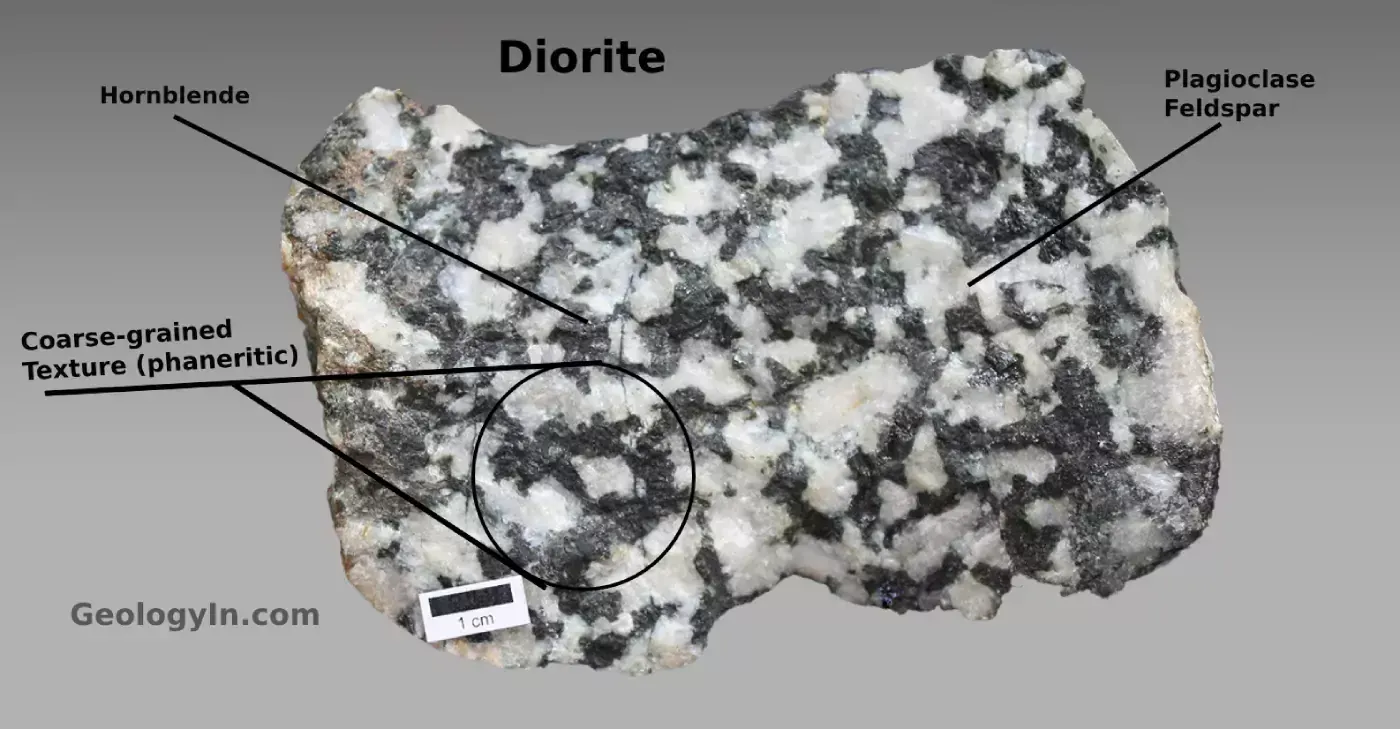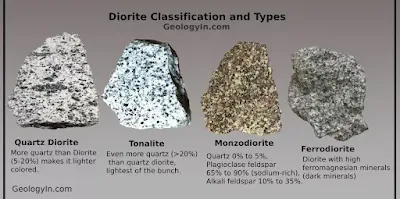Diorite: Composition, Properties, Occurrence, Uses
Diorite is an intrusive, coarse-grained, igneous rock, meaning it forms from the slow cooling and solidification of magma (molten rock) underground. Diorite is typically composed of plagioclase feldspar, hornblende, biotite, and/or pyroxene minerals. Plagioclase feldspar is a type of feldspar that is rich in sodium and calcium.
Diorite has a moderate silica content and is intermediate in composition between granite (high silica) and gabbro (low silica). This gives diorite a distinct "salt and pepper" appearance, due to the presence of both light-colored plagioclase feldspar and dark-colored minerals like hornblende or biotite.
Diorite commonly occurs in large intrusions, dikes, and sills within continental crust. These formations are often found above convergent plate boundaries where an oceanic plate subducts beneath a continental plate.
The term "diorite" comes from the Greek word "diorizein," which means "to distinguish" or "to separate." This likely refers to its distinction from granite, another common igneous rock.
Diorite Profile
- Category: Intrusive,
- Color: Medium to dark gray.
- Texture: Coarse-grained (phaneritic).
- Hardness: 6-7 on Mohs scale.
- Chemical Composition: Intermediate, Moderate silica content.
- Mineral composition: plagioclase feldspar (andesine), hornblende, and biotite.
Diorite Composition
Diorite is an igneous rock classified as an intermediate intrusive (plutonic) rock based on its geochemical composition. This translates to a position between felsic rocks (high silica content) and mafic rocks (low silica content).
Mineral Composition of Diorite
Plagioclase Feldspar: The dominant mineral in diorite is plagioclase feldspar, specifically a sodium-rich variety known as andesine. This silicate mineral contributes the light-colored aspect to the rock.
Mafic Minerals:
- Hornblende: A prevalent dark-colored amphibole mineral, hornblende plays a significant role in the "salt and pepper" texture characteristic of diorite. Its abundance directly influences the overall darkness of the rock.
- Biotite: Another dark-colored mineral, biotite (a mica), can also be present in diorite. Its presence adds to the mafic component and exhibits a platy or flaky structure.
- Pyroxene: Less commonly, pyroxene, another dark-colored silicate mineral group, may be found in diorite.
Trace Minerals:
Diorite typically contains minor quantities of additional minerals such as zircon, apatite, sphene, magnetite, ilmenite, and sulfides. These minerals are present in trace amounts and have minimal impact on the overall geochemical characteristics of the rock.
Quartz: Diorite typically contains little to no quartz. However, varieties with more than 5% quartz are classified as quartz diorite or tonalite.
Diorite Classification and Types
Geologists employ the modal abundance (percentage by volume) of key minerals to classify diorite:
Quartz Diorite: When quartz content surpasses 5% but remains less than 20%, the rock is classified as quartz diorite. This additional quartz imparts a slightly lighter color compared to diorite.
Tonalite: If the quartz content exceeds 20%, the classification transitions to tonalite.
Monzodiorite/Granodiorite: The presence of potassium feldspar (orthoclase) exceeding 10% necessitates further classification based on the abundance of plagioclase feldspar. If plagioclase feldspar remains dominant, the rock is classified as monzodiorite. However, if potassium feldspar content is comparable to plagioclase feldspar, the classification shifts to granodiorite.
Ferrodiorite: The presence of olivine and iron-rich augite pyroxene steers the rock composition towards ferrodiorite. This classification signifies a transitional form between diorite and gabbro (a mafic rock).
Properties of Diorite
Color: Diorite typically exhibits a gray to black coloration, often with speckles of lighter minerals such as feldspar. The exact color can vary depending on the mineral composition and geological conditions during formation.
Texture: Diorite has a coarse-grained texture, meaning that individual mineral grains are visible to the naked eye. These grains give the rock a granular appearance. The texture may appear uniform or exhibit banding or layering, depending on the specific conditions of formation.
Grain Size: The grain size of diorite is typically medium to coarse-grained. This means that individual mineral grains are large enough to be seen without magnification. The grain size is a result of the slow cooling of magma within the Earth's crust, allowing minerals to crystallize and grow over time.
Hardness: Diorite has a hardness ranging from 6 to 7 on the Mohs scale, making it relatively hard compared to other common minerals. This hardness contributes to its durability and suitability for various construction and architectural applications.
Density: The density of diorite typically ranges from 2.8 to 3.0 grams per cubic centimeter. This density falls between that of lower-density felsic rocks like granite and higher-density mafic rocks like basalt.
Weathering Resistance: Diorite is generally resistant to weathering and erosion due to its composition and hardness. However, like all rocks, it can undergo physical and chemical weathering processes over time when exposed to the elements. These processes may lead to the breakdown of minerals and the eventual disintegration of the rock into smaller particles.
 |
| Typical Diorite thin-section. |
Occurrence: Where is diorite found?
Diorite, while not the most common igneous rock, can be found around the world in various geological settings associated with plate tectonics. Here's a breakdown of where you're likely to encounter diorite:
Subduction Zones and Volcanic Arcs: At convergent plate boundaries, subduction zones play a critical role. Subduction, the process where one tectonic plate descends beneath another, triggers partial melting of the subducted slab, generating magma with specific geochemical characteristics. Upon intrusion into the overlying crust under appropriate pressure-temperature conditions, this magma can crystallize as diorite. Consequently, volcanic arcs, mountain ranges formed due to subduction, are frequently host to diorite plutons. The Andes Mountains of South America exemplify this association.
Cordilleran Orogeny: Orogenic (Mountain-building events) along continental margins, termed Cordilleran orogenesis, can also facilitate diorite formation. The immense pressure and elevated temperatures associated with these events can induce partial melting of existing crustal rocks. The resultant magma, upon intrusion, crystallizes as diorite plutons. The Rocky Mountains showcase occurrences of diorite formed during such orogenic processes.
Diorite is commonly found in various intrusive igneous rock formations like:
- Batholiths: These are massive, dome-shaped plutons, and diorite can be a significant component, particularly in cordilleran mountain belts.
- Stocks: Smaller plutons than batholiths, stocks can also harbor diorite deposits.
- Sills: These are sheet-like igneous intrusions that occur parallel to the existing rock layers.
- Dikes: These are narrow, vertical igneous intrusions that cut across existing rock layers.
 |
| Gabbro & diorite & granite dikes. Devonian; Hulls Cove, Mt. Desert Island, Maine, USA Photo: James St. John |
Global Distribution
Diorite is found on all continents, though not as abundantly as some other igneous rocks like granite. Here are some notable locations:
North America: Diorite is widespread throughout North America, occurring in various geological settings. Significant deposits can be found in regions such as the Sierra Nevada mountains in California, the Cascade Range in the Pacific Northwest, the Canadian Shield in Canada, and the Appalachian Mountains in the eastern United States.
Europe: Diorite is found in several European countries, including Norway, Sweden, Finland, Scotland, Spain, and Italy. It is commonly associated with mountainous regions and ancient continental crust.
Asia: Diorite occurs in many parts of Asia, particularly in areas with active tectonic activity and volcanic activity. Countries such as Russia, China, Japan, and India have notable occurrences of diorite.
Africa: Diorite is found in various African countries, including South Africa, Zimbabwe, Madagascar, and the Democratic Republic of the Congo. It is often associated with Precambrian shield regions and ancient geological formations.
Australia and Oceania: Diorite occurs in regions across Australia, particularly in areas with ancient geological histories such as the Yilgarn Craton in Western Australia. It is also found in parts of New Zealand and other Pacific island nations.
South America: Diorite is present in several South American countries, including Brazil, Chile, Peru, and Argentina. It is commonly associated with the Andes Mountains and other mountain ranges formed by tectonic activity.
 |
| Medium grains Diorite |
Uses of Diorite
Diorite has several practical and aesthetic uses due to its durability, attractive appearance, and suitability for various applications. Some common uses of diorite include:
Construction Stone: Diorite is utilized as a construction material for building facades, walls, and flooring due to its strength and resistance to wear and tear. Its hardness and durability make it suitable for both interior and exterior applications in residential, commercial, and industrial buildings.
Decorative Stone: Diorite is prized for its aesthetic qualities, including its distinctive speckled appearance and variety of colors. It is often used as a decorative stone in countertops, tabletops, vanities, and other architectural features. Diorite's polished surface can enhance the visual appeal of interior spaces and add a touch of sophistication to design projects.
Monuments and Sculptures: Diorite has been used historically in the creation of monuments, sculptures, and artistic works due to its ability to hold intricate details and withstand weathering over time. Ancient civilizations such as the Egyptians and the Assyrians utilized diorite for sculpting statues and ceremonial objects, showcasing its enduring beauty and cultural significance.
Landscaping and Outdoor Projects: Diorite is commonly used in landscaping projects for pathways, garden borders, retaining walls, and decorative rockeries. Its natural appearance and resistance to weathering make it well-suited for outdoor applications where durability and aesthetics are important considerations.
Crushed Stone and Aggregates: Diorite can be crushed and used as a raw material for producing aggregates, gravel, and crushed stone for construction purposes. These materials are used in road construction, concrete production, and drainage systems, providing essential support for infrastructure projects.
Aquariums and Terrariums: Diorite's natural beauty and texture make it a popular choice for aquarium and terrarium decorations. It can be used as substrate or as decorative accents in aquatic and terrestrial habitats, creating a visually appealing environment for fish, reptiles, and plants.
Overall, diorite's versatility and aesthetic appeal make it a valuable resource in various industries, from construction and architecture to art and landscaping. Its enduring qualities and ability to withstand the elements ensure that it remains a popular choice for a wide range of applications worldwide.
 |
| Diorite Vases |
Differentiating Diorite From Other Rocks
Distinguishing diorite from other rocks involves examining several key characteristics, including color, texture, mineral composition, and geological context. Here's how diorite can be differentiated from some common rocks:
Granite: Granite and diorite are both intrusive igneous rocks with similar coarse-grained textures, but they differ in mineral composition, the presence of abundant quartz crystals. Granite contains mainly quartz, feldspar, and mica minerals, giving it a lighter color and often a more speckled appearance compared to diorite's darker, predominantly plagioclase feldspar-based composition.
Gabbro: Gabbro is another coarse-grained igneous rock similar to diorite, but it typically lacks the lighter-colored minerals found in diorite. Gabbro is composed primarily of pyroxene (diorite's dominance of hornblende and biotite) and calcium-rich plagioclase feldspar, giving it a darker, more uniform appearance compared to diorite. Gabbro may have a slightly more equigranular texture (similar-sized crystals) compared to diorite's potential for some variation in crystal size.
Basalt: Basalt is a fine-grained igneous rock that differs significantly from diorite in texture and mineral composition. Basalt has a much finer texture with crystals too small to be discerned with the naked eye, due to its rapid cooling at the Earth's surface, and it is composed mainly of pyroxene and calcium-rich plagioclase feldspar, with little to no quartz or feldspar crystals present.
Andesite: Andesite is an intermediate volcanic rock that shares some similarities with diorite, but it typically has a finer texture and is formed through volcanic rather than intrusive processes. Andesite is composed primarily of plagioclase feldspar and pyroxene minerals, with smaller amounts of amphibole or biotite.
Granodiorite: Granodiorite shares some similarities with diorite but has a higher potassium feldspar (orthoclase) content compared to diorite's plagioclase feldspar dominance. This can result in a slightly lighter color for granodiorite.
Schist: Schist is a metamorphic rock that can sometimes be mistaken for diorite due to its coarse-grained texture and similar coloration. However, schist forms through the metamorphism of existing rocks and often exhibits a foliated texture with visible mineral layers, whereas diorite is a primary igneous rock with a non-foliated texture.
Field Techniques:
In the field, geologists can employ various techniques to differentiate diorite from these rocks:
Hand Lens Examination: Examining the rock with a hand lens can reveal the presence of quartz (clear, glassy) in granite and the absence in diorite. The grain size and presence of foliation can also be helpful clues.
By examining these key characteristics, including mineral composition, texture, and formation process, geologists and rock enthusiasts can differentiate diorite from other rocks and identify its unique properties.
Conclusion
Diorite is a geologically significant igneous rock offering insights into the processes shaping the Earth's crust. Its characteristic mineralogical composition and intrusive origin make it a valuable tool for geologists in understanding past tectonic events. While not as widely utilized as some other igneous rocks, diorite's historical significance and functional applications solidify its place as a noteworthy rock type.



%20(1).webp)






